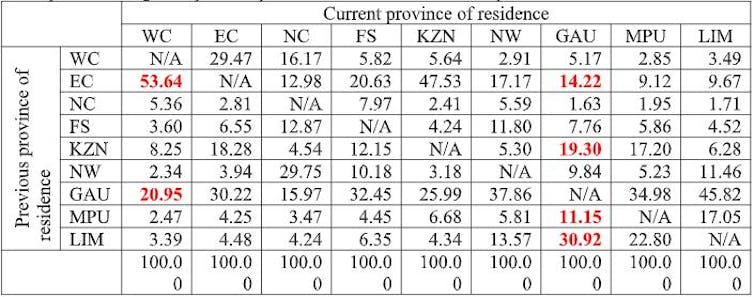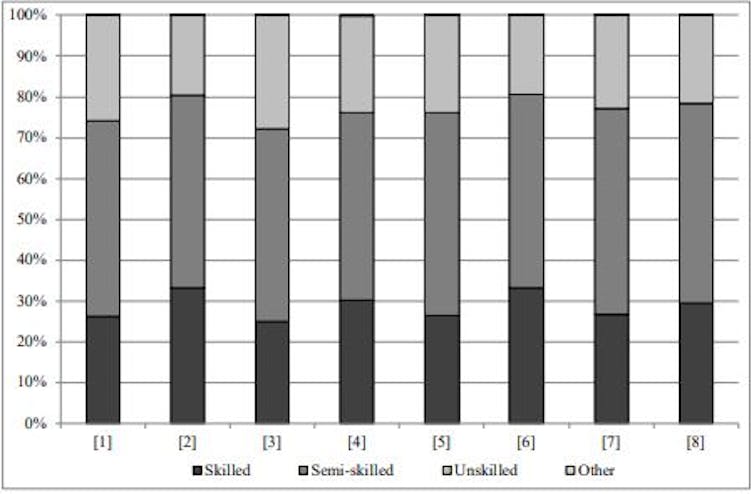
Derek Yu, University of the Western Cape
Labour migration is an essential – and potentially beneficial – part of all economies, regions and countries in the 21st century. One of the main reasons for migration is to enjoy better employment and earnings prospects.
The usual flow of people is from developing to developed countries at the international level, and domestically from rural to urban areas or from poorer areas to richer ones.
In South Africa two provinces – Gauteng and Western Cape – stand out among the full complement of nine – as the most attractive destinations for labour migrants. They contribute most to the economic success of the country, accounting for 49% of the gross domestic product in 2019.
Our study used the South African Census 2011 data to examine the impact of inter-provincial migration on the labour market in the Western Cape and Gauteng. Our specific focus was on whether the inter-provincial migrants fared relatively better in the labour market in the destination provinces.
Our key finding was that migrants from other provinces were more likely to be employed than the permanent residents of Gauteng and the Western Cape. But, the intra-provincial migrants – people who moved from one area to another within the same province in search of better job prospects – remained the best-performing group with the lowest unemployment rates, especially in the formal sector.
As not all inter-provincial migrants find work in the destination provinces, the provincial unemployment statistics should be interpreted with great caution, as they can be distorted by these migrants.
The study
In our study, we used the Census 2011 data – the most recent – to examine the personal, socioeconomic status and labour market characteristics of eight groups of people aged 15 to 64 years.
The categories were, in the case of the Western Cape:
permanent residents,
intra-provincial migrants,
long-term migrants from other provinces,
short-term migrants from other provinces.
In the case of Gauteng:
permanent residents,
intra-provincial migrants,
long-term migrants from other provinces,
short-term migrants from other provinces.
Short-term and long-term migrants were distinguished from each other based on the time periods before and after 2006. The short term refers to those who migrated within the last five years. Long-term means they migrated more than 5-10 years earlier.
The findings point to the need for the national government to consider inter-provincial migration when allocating the national budget to provinces, districts and municipalities. More of the budget should go to the Western Cape and Gauteng, given their ever-growing populations because of migration from other provinces.
Key findings
The majority of migrants into the Western Cape came from the Eastern Cape (53.64%) and Gauteng (20.95%). In contrast, migrants into Gauteng were more evenly spread. They came mostly from Limpopo (30.92%), KwaZulu-Natal (19.30%), the Eastern Cape (14.22%) and Mpumalanga (11.15%) provinces.
Inter-provincial migrants’ previous province of residence and current province of residence

The statistics also indicated that the majority of migrants from other provinces into the Western Cape settled in the City of Cape Town (over 70%). On the other hand, nearly 90% of migrants into Gauteng resided in Johannesburg, Tshwane and Ekurhuleni districts.
The results suggest that these popular destination districts are most likely associated with better living conditions and labour market prospects.
Furthermore, both short and long-term migrants into Gauteng and the Western Cape were likely to be young, aged 15-34 years. They were mostly unmarried African urban residents with 11 to 12 years of education on average.
These migrants into Gauteng and the Western Cape enjoyed lower unemployment rates than the permanent residents. One interesting finding was that the intra-provincial migrants had the lowest unemployment rate, compared with the inter-provincial migrants and permanent residents.
Labour force participation rates and unemployment rates of the eight groups of individuals

The figure below shows that the proportion of workers involved in skilled occupations was the highest for the intra-provincial migrants. More short-term and long-term inter-provincial migrants were in skilled work compared to the permanent residents.
Percentage share of employed in each skills level by migration status

Lastly, after controlling for differences in other personal and household characteristics, the econometric analysis found that, compared to the permanent residents, both short and long-term inter-provincial migrants into the Gauteng and the Western Cape enjoyed a significantly greater probability (of 3%) of finding work. Migrants within a province enjoy the lowest unemployment rate and probability of engaging in skilled occupations.
Policy implications
Job-seeking migration into Gauteng and the Western Cape will certainly continue for as long as these two provinces are associated with better economic conditions and job prospects than the migrants’ home provinces. In particular, these migrants are most likely to cluster in certain districts with more lucrative job opportunities; namely Cape Town, Ekurhuleni, Johannesburg and Tshwane.
Gauteng and Western Cape provincial governments will continue to face important challenges in addressing the increased burden on providing basic services, housing, health, education and social service systems because of the flow of migrants.
The findings indicate that not all the inter-provincial migrants eventually find work. This adds to the unemployment burden for Gauteng and the Western Cape. This has implications for the provinces’ job creation and entrepreneurship development strategies.
Joseph Kleinhans, an Economics Masters graduate at the University of the Western Cape, collaborated on the research on which this article is based.![]()
Derek Yu, Professor, Economics, University of the Western Cape
This article is republished from The Conversation under a Creative Commons license. Read the original article.

